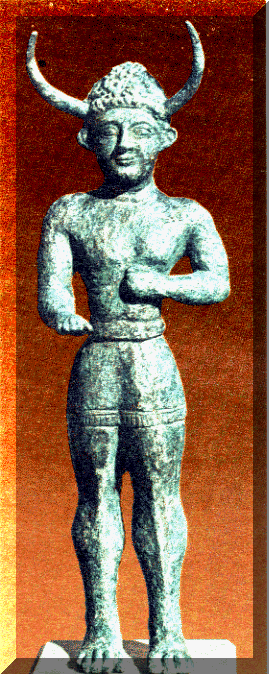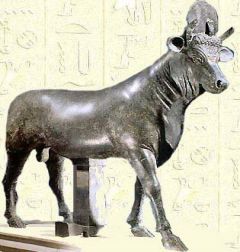And Eusebius reported the further events :
(17) Then Aaron the brother of Moses, having learned about the plot, advised his brother to flee into Arabia; and he took the advice, and sailed across the Nile from Memphis, intending to escape into Arabia. (18) But when Chanethothes was informed of the flight of Moses, he lay in ambush intending to kill him; and when he saw him coming, he drew his sword against him, but Moses was too quick for him, and seized his hand, and drew his sword and slew Chanethothes. (19) So he made his escape into Arabia.
Eusebius, Praeparatio Evangelica, IX, 27 :
(1) And Artapanus says, in his book "Concerning the Jews", that after the death of Abraham, and of his son Mempsasthenoth, and likewise of the king of Egypt, his son Palmanothes succeeded to the sovereignty. (2) This king behaved badly to the Jews; and first he built Kessa, and founded the temple therein, and then built the temple in Heliopolis. (3) He begat a daughter Merris, whom he betrothed to a certain Chenephres, king of the regions above Memphis (for there were at that time many kings in Egypt); and she being barren took a supposititious child from one of the Jews, and called him Mouses (Moses): but by the Greeks he was called, when grown to manhood, Musaeus. (4) And this Moses, they said, was the teacher of Orpheus; and when grown up he taught mankind many useful things … (5) All these things he did for the sake of keeping the sovereignty firm and safe for Chenepbres. For previously the multitudes, being under no order, now expelled and now set up kings, often the same persons, but sometimes others…(7) But when Chenephres perceived the excellence of Moses he envied him, and sought to slay him on some plausible pretext. And so when the Aethiopians invaded Egypt, Chenephres supposed that he had found a convenient opportunity, and sent Moses in command of a force against them, and enrolled the body of husbandmen for him, supposing that through the weakness of his troops he would easily be destroyed by the enemy. (8) But Moses with about a hundred thousand of the husbandmen came to the so-called Nome of Hermopolis, and there encamped; and sent generals to pre-occupy the country, who gained remarkable successes in their battles. He adds that the people of Heliopolis say that this war went on for ten years. (9) So Moses, because of the greatness of his army, built a city in this place, and therein consecrated the ibis, because this bird kills the animals that are noxious to man. And he called it Hermopolis (Ounou the city of god Thoth, the capital of the Hare nome). (10) Thus then the Aethiopians (Nubians), though they were enemies, became so fond of Moses, that they even learned from him the custom of circumcision: and not they only, but also all the priests…(11) But when the war was ended, Chenephres pretended to welcome him, while in reality continuing to plot against him. ... (13) But when the Egyptians were alienated from him, he bound his friends by an oath not to report to Moses the plot which was being contrived against him, and he appointed the men who were to kill him. (14) When however no one would obey him, Chenephres reproached Chanethothes, whom he had especially addressed; and he, on being thus reproached, promised to make the attempt when he found an opportunity. (15) And Merris having died about this time, Chenephres professed to give the body to Moses and Chanethothes to carry it over into regions beyond Egypt and bury it, supposing that Moses would be slain by Chanethothes. (16) But while they were on the way, one of those who were cognizant of the plot reported it to Moses; and he being on his guard buried Merris himself, and in her memory he called the river and the city thereby Meroe. And this Merris is honoured by the people of the country not less highly than Isis.
At first glance this text seems very obscure because the names of its characters are unknown by egyptologists. It is thus necessary to remove this veil of misunderstanding. Firstly we must consider that we are in the time when Hyksos occupied Lower Egypt. The country was divided into two kingdoms: the North with its capital Avaris which king Apophis Aâqen-en-re was Asian (Cananean]), the South which capital Thebes have been abandoned by its last Egyptian king (probably Antef VII Nub-kheper-re) and was after that governed by a couple of Asian rulers Se-qen-en-re Tao and his queen Ah-hotep, who were married brother and sister and close relatives of the ruler of Avaris and therefore his vassals. (Cf. According to Eusebius of Cesaree citing Manetho: "The seventeenth dynasty : They were shepherds and brothers. They were foreign from Phoenicia, who took Memphis").
We propose therefore to recognize in Palmanothes Apophis Aa-user-re the old Syrian king, whereas Chenephres would rather be Aa-qen-en-Re, his son reigning in Avaris. Aa-qen-en-re had been confounded here with his brother Se-qen-en-re who reigned in Thebes with his sister-spouse queen Ah-hotep. It appears therefore that the daughter of Apophis (wrongly called Merris as we will see ) is Ah-hotep. Ah-hotep had adopted Kamose when child (who actually was her genuine son, fruit of an incest with king Apophis Aa-user-Re, her own father). This child become adult was a threat to the ruler of Avaris and this one asked his brother Se-qen-en-Re king of Thebes to get rid of the young man. To do so, Kamose (Moses) was sent to fight Nubian invaders with an army of inexperienced farmers. But Kamose won a great glory by his victories against Nubians who themselves pay homage to him. Aa-qen-en-Re king of Avaris then ordered his brother Se-qen-en-Re Tao (Chanethothes) to kill Kamose (aka Moses). We can remark that Se-qen-en-Re Tao was himself under the sign of god Toth (as Tao = Djehuti), like Kamose who was reputed to have founded Hermopolis the city of god Thoth to which he gave the appearance of an ibis (cf. the prince of Iabesh of the tomb of Beni-Hassan), whereas this god was before represented as a baboon.
Then happened the death of the adoptive mother of Moses named Merris. As we know, queen Ah-hotep lived very old and died under the reign of Ahmose, thus this Merris cannot be the mother of Kamose spouse of Se-qen-en-re Tao. Here it is necessary to know that before to join the court of Thebes, Kamose protected by the former Theban king Antef VII living in exile in Nubia had been probably reared by the second spouse of Antef, a Nubian princess born in Meroe, that explains her nickname of Merris. This is confirmed by the fact that she was to be buried out of Egypt and that Kamose warned of the danger he ran in enterprising the journey buried her in Egypt, in a place that he called Meroe. Now this place get us to think to the name of lake Moeris in the Fayum oasis, close to the funeral city of Sesostris II in Illahun. Indeed, it is in the basement of this city that was found a family tomb which first occupant was named Meket (cf. Makeda the queen of Saba-Meroe) and had next to her some baskets of Nubian style. (See our page on the funeral city of Sesostris II).
And in the Bible Latin version named Vulgate we find the following information (Exodus 34: 29) : "And when Moses came down from the Mount Sinai, he held the two tables of the testimony, and he did not know that his face was horned after his conversation with the Lord". The other versions of Bible say "His face was radiant because he had spoken with the Lord". It is a fact that in Hebrew language, the root of the two words is the same. But the Latin translation of Saint Jerome could be right if Moses was Kamose whose name in Egyptian language means "the son of the bull" : the reason why Hebrew people made for him a golden calf.
In fact, the book of Exodus didn't say anything concerning the life of Moses between his birth and adoption by the daughter of pharaoh and the time when he met Hebrews reduced in slavery in Egypt. But there are numerous data concerning this period in late traditions reported by ancient authors, which are considered as non canonic. The following one deserves to be taken into consideration in the context of the Hyksos occupation of Lower Egypt :

Exodus 32, 3-4: "And all the people brake off the golden earrings which were in their ears, and brought them to Aaron. And he received them from their hands, and fashioned it with a graving tool, after he had made it a molten calf: and they said : This will be thy god, O Israel, who brought thee up out of the land of Egypt. "

Kamose "the Bull's Son" :
Was he Moses ?
"Moses was greatly estimed in Egypt
by the servants of pharaoh and by his people." (Exodus 11:3)
Polemo in the first book of his Hellenic History reported "In the time of Apis son of Phoroneus a part of the Egyptian army was expelled from Egypt, who took up their abode not far from Arabia in the part of Syria called Palestine" being evidently those who went with Moses (cited by Eusebius "Præparatio Evangelica, X. 40: 6, from Georgius Syncellus "Chronicles, Book III) .
N.B. : Consequently, it appears there that king Se-qen-en-re did be killed in undetermined circumstances, not by henchmen of the Hyksos king, but by his own nephew Kamose in self-defense. (According to another tradition he had been killed when bathing in the Nile, what could explain why only the head of Se-qen-en-re had been struck and his body had begun to decompose before being mummified as it appears from the state of his mummy).
The testimony of Eusebius is also consistent with the late Egyptian tale reporting the complain of king Apophis to Se-qen-en-re concerning the bellowing of Theban hippos which prevented him from sleeping (900 km far to north). Indeed Kamose could be still the leader of some Theban partisans planning to recover Lower Egypt from Hyksos, while the courtiers accepted the statu quo which allowed us to let their cattle graze in the delta marshes.
It is therefore after these events that Kamose, unwillingly become a murderer, was appealed to defend the throne of Thebes remained in the hands of queen Ah-hotep, (his own mother and the widow of king Se-qen-en-re) become regent of the future king Ahmose who was still a child.